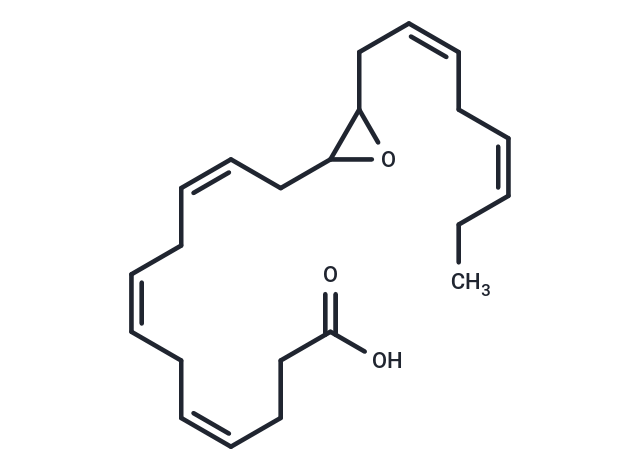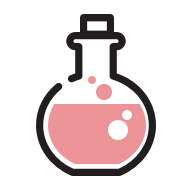- Remove All
 Your shopping cart is currently empty
Your shopping cart is currently empty
Shopping Cart
(±)13(14)-EpDPA
Catalog No. T35496Cas No. 895127-64-7
Cytochrome P450 metabolism of polyunsaturated fatty acids produces numerous bioactive epoxide regioisomers. (±)13(14)-EpDPA is a docosahexaenoic acid epoxygenase metabolite, derived via epoxidation of the 13,14-double bond of DHA. It has been detected in rat brain and spinal cord and is a preferred substrate for soluble epoxide hydrolase with a Km value of 3.2 μM. (±)13(14)-EpDPA demonstrates antihyperalgesic activity in inflammatory and neuropathic pain models. (±)13(14)-EpDPA and other epoxy metabolites of DHA are also reported to potently inhibit angiogenesis and tumor growth in in vitro assays.

(±)13(14)-EpDPA
Catalog No. T35496Cas No. 895127-64-7
Cytochrome P450 metabolism of polyunsaturated fatty acids produces numerous bioactive epoxide regioisomers. (±)13(14)-EpDPA is a docosahexaenoic acid epoxygenase metabolite, derived via epoxidation of the 13,14-double bond of DHA. It has been detected in rat brain and spinal cord and is a preferred substrate for soluble epoxide hydrolase with a Km value of 3.2 μM. (±)13(14)-EpDPA demonstrates antihyperalgesic activity in inflammatory and neuropathic pain models. (±)13(14)-EpDPA and other epoxy metabolites of DHA are also reported to potently inhibit angiogenesis and tumor growth in in vitro assays.
| Pack Size | Price | Availability | Quantity |
|---|---|---|---|
| 25 μg | Inquiry | 35 days | |
| 50 μg | Inquiry | 35 days | |
| 100 μg | Inquiry | 35 days | |
| 500 μg | Inquiry | 35 days |
Bulk & Custom
Add to Cart
Questions
View MoreContact us for more batch information
Resource Download
Product Introduction
Bioactivity
Chemical Properties
| Description | Cytochrome P450 metabolism of polyunsaturated fatty acids produces numerous bioactive epoxide regioisomers. (±)13(14)-EpDPA is a docosahexaenoic acid epoxygenase metabolite, derived via epoxidation of the 13,14-double bond of DHA. It has been detected in rat brain and spinal cord and is a preferred substrate for soluble epoxide hydrolase with a Km value of 3.2 μM. (±)13(14)-EpDPA demonstrates antihyperalgesic activity in inflammatory and neuropathic pain models. (±)13(14)-EpDPA and other epoxy metabolites of DHA are also reported to potently inhibit angiogenesis and tumor growth in in vitro assays. |
| Molecular Weight | 344.495 |
| Formula | C22H32O3 |
| Cas No. | 895127-64-7 |
| Relative Density. | 0.994 g/cm3 (Predicted) |
Storage & Solubility Information
| Storage | Powder: -20°C for 3 years | In solvent: -80°C for 1 year | Shipping with blue ice. | |||||||||||||||||||||||||
| Solubility Information | DMSO: 20 mg/mL (58.06 mM), Sonication is recommended. Ethanol:PBS(pH 7.2) (1:1): 0.5 mg/mL (1.45 mM), Sonication is recommended. DMF: 25 mg/mL (72.57 mM), Sonication is recommended. Ethanol: 50 mg/mL (145.14 mM), Sonication is recommended. | |||||||||||||||||||||||||
Solution Preparation Table | ||||||||||||||||||||||||||
DMSO/DMF/Ethanol
| ||||||||||||||||||||||||||
Calculator
In Vivo Formulation Calculator (Clear solution)
Please enter your animal experiment information in the following box and click Calculate to obtain the mother liquor preparation method and in vivo formula preparation method:
Mother liquor preparation method: 2 mg of drug dissolved in 50 μL DMSO (mother liquor concentration of 40 mg/mL), if you need to configure a concentration that exceeds the solubility of the product, please contact us first.
(mother liquor concentration of 40 mg/mL), if you need to configure a concentration that exceeds the solubility of the product, please contact us first.
Preparation method for in vivo formula: Take 50 μL DMSO main solution, add 300 μLPEG300
main solution, add 300 μLPEG300 mix well and clarify, then add 50 more μL Tween 80, mix well and clarify, then add 600 more μLddH2O
mix well and clarify, then add 50 more μL Tween 80, mix well and clarify, then add 600 more μLddH2O mix well and clarify
mix well and clarify
For Reference Only. Please develop an appropriate dissolution method based on your laboratory animals and route of administration.
Dose Conversion
You can also refer to dose conversion for different animals. More Dose Conversion
Tech Support
Please see Inhibitor Handling Instructions for more frequently ask questions. Topics include: how to prepare stock solutions, how to store products, and cautions on cell-based assays & animal experiments, etc
Related Tags: buy (±)13(14)-EpDPA | purchase (±)13(14)-EpDPA | (±)13(14)-EpDPA cost | order (±)13(14)-EpDPA | (±)13(14)-EpDPA chemical structure | (±)13(14)-EpDPA formula | (±)13(14)-EpDPA molecular weight

Copyright © 2015-2025 TargetMol Chemicals Inc. All Rights Reserved.




